The Difference Between Infrared And Radio Frequency
Electromagnetic Radiation Is One Of The Most Interesting And Vital Phenomena In Physics, Which Has Been Studied For Various Reasons Throughout Human History.
Due to their differences, this radiation includes different wave types with other characteristics and applications.
In the following, two types of electromagnetic radiation, infrared and radio frequency, which the human eye cannot see, are examined. After declaring the difference between infrared and radio frequency, we review some practical applications together.
Have you ever wondered how you could talk on your cell phone, watch TV or use remote control, measure your body temperature, or even manage spectacular pictures from space?
The answer to these questions lies in a fascinating and surprising scientific phenomenon: The electromagnetic spectrum.
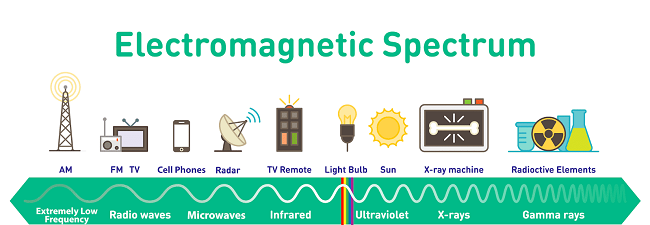 Electromagnetic spectrum
Electromagnetic spectrum
This phenomenon includes different types of waves that can have other characteristics and applications due to differences in wavelength and frequency. Some locks are visible (like visible light), and some, like infrared waves (Infrared) or radio frequency, are not visible to the naked eye.
Electromagnetic waves are produced and propagated by two key factors, wavelength, and frequency, which also determine the difference between infrared and radio frequency. Wavelength is the distance between two similar points on a wave, and frequency is the number of repetitions of a wave rotation per second. These two have an essential role in the physical properties, chemical properties, and applications of electromagnetic waves.
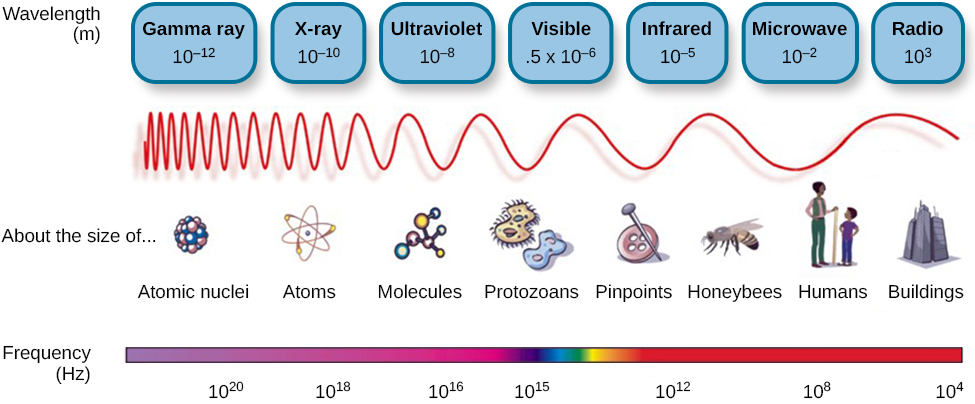 Wavelength and frequency in electromagnetic waves
Wavelength and frequency in electromagnetic waves
It is interesting to know that wavelength and frequency have an inverse relationship, meaning that the longer the wavelength, the lower the frequency, and the shorter the wavelength, the higher the frequency.
The electromagnetic spectrum includes different regions separated by differences in wavelength and frequency. These areas include radio waves, infrared, ultraviolet, X-ray, and gamma rays.
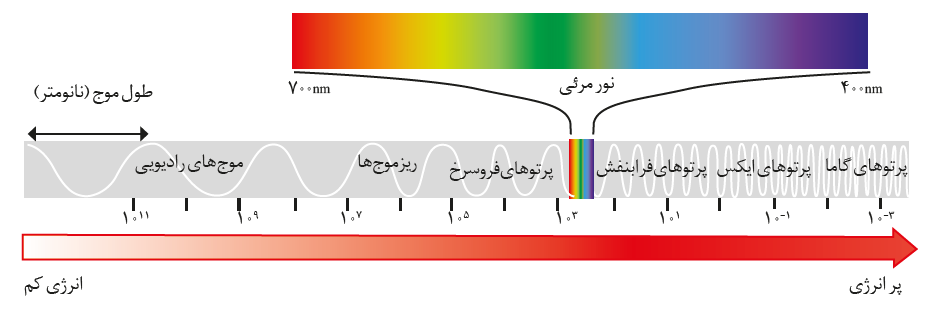 Colors visible to the human eye are only a tiny part of the electromagnetic spectrum.
Colors visible to the human eye are only a tiny part of the electromagnetic spectrum.
Each of these areas has its characteristics and applications that are used in different sciences and industries. In the following, two types of electromagnetic radiation called radio waves and infrared, which the human eye cannot see will be investigated as the difference between radio waves and infrared.
What is Infrared?
Infrared is a type of electromagnetic radiation whose wavelength is longer than visible light and shorter than radio waves. This radiation is not visible to the human eye but can be detected and used with special devices.
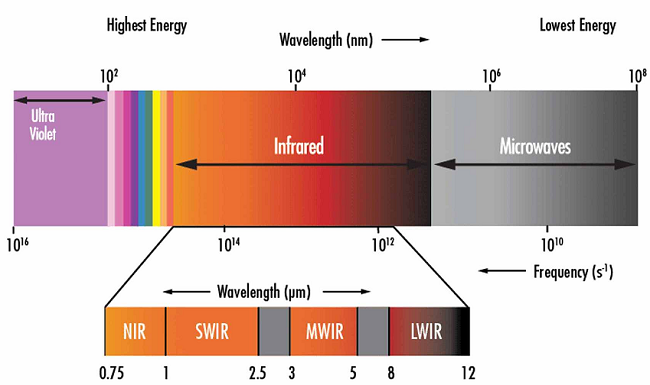
Infrared sources exist in natural sources like the sun and artificial sources like infrared lamps. This radiation has various applications in science, industry, medicine, communication, and heating.
What is radio frequency?
Radiofrequency or RFIt is a type of electromagnetic radiation whose wavelength (according to the ITU classification) is from 2.73 mm (110 GHz) to 10 thousand kilometers (30 Hz). This type of radiation, like infrared, is not visible to the naked human eye but can be detected with special devices.
Radiofrequency exists in natural sources such as the sun and artificial sources such as radio and television antennas. It has various applications in science, industry, medicine, communication, and tracking.
Difference between infrared and radio frequency
As mentioned, the difference between radio and infrared is frequency and wavelength. Infrared has a shorter wavelength and higher frequency than RFI, in the frequency range of 300 GHz to 428 terahertz, and the wavelength is 1 mm to 700 nm, while the radio frequency is 30 Hz to 110 GHz. The wavelength is 2.73 meters to 10 thousand kilometers.
Remember that the exact definition of the boundary between different regions of the electromagnetic spectrum is different in most references. For example, some references describe millimeter and terahertz wavelengths as separate areas due to specific applications. In addition, in some categories, radio frequency is placed in the frequency range of 3 Hz to 300 GHz and the wavelength of 10 mm to 10 thousand kilometers.
Another difference between the two is heat production. Infrared heat various objects after hitting them, while radio frequency does not have this property. This issue has caused infrared waves to heat different spaces and things, while radio frequency is used in information and energy transmission.
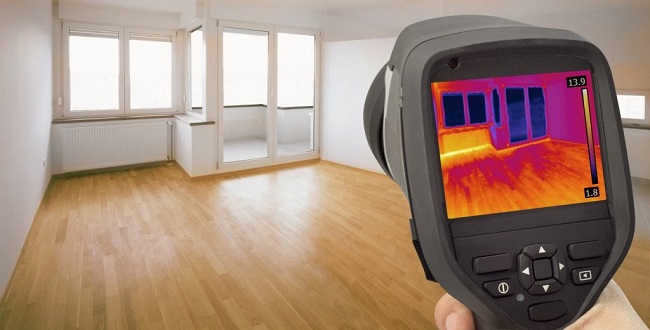
Infrared and radio frequencies have different and sometimes similar applications. For example, some of the applications of infrared are thermal cameras, remote controls, mobile phones, physiotherapy, spectroscopy, and night vision tools. On the other hand, some radio frequency applications are radar systems, television, radio, mobile phones, Wi-Fi, Bluetooth, and GPS.
Applications of infrared waves and radio frequency
As mentioned, infrared waves and radio frequency have many and varied applications in daily life, science, industry, medicine, military, etc.
Thermal cameras: These devices use special sensors to identify and image the infrared radiation produced by hot objects. These devices are used in various fields, including medicine, military, astronautics, geology, and art. For example, a thermal camera can measure a person’s body temperature or see animals at night.
 Image recorded by thermal cameras
Image recorded by thermal cameras
Cellular phone: Another modern device that has become an inseparable part of our lives today are smartphones, which uses radio frequency waves to establish wireless communication and transmit sound.
Remote control: One of the tools based on infrared technology we have used many times daily is remote controls. These devices use LEDs. The red ones can send pulses of infrared radiation and communicate with electronic devices such as TV, radio, air conditioner, etc.

Television: Thanks to their antennas, these devices can transfer radio frequency waves, images, and sound wirelessly between themselves and the broadcasting network. For example, by using TV, you can watch news, entertainment, educational programs, etc.
The things mentioned in this article are only a few examples of the applications of infrared waves and radio frequency. These two types of electromagnetic radiation have more and broader applications used in science, industry, medicine, military, astronautics, art, geology, etc.
Frequently asked questions
How to detect infrared radiation and radio frequency?
The difference between infrared and radio frequency is wavelength and frequency, so we need different sensors and devices to identify them. Thermal cameras, temperature gauges, spectrometers, and remote controls are used to detect infrared radiation. Some instruments that detect radiofrequency radiation are radar, television, radio, mobile phone, Wi-Fi, Bluetooth, and GPS.
Is radio frequency the same as infrared?
No, infrared or radio frequency are two different types of electromagnetic radiation that differ in wavelength, frequency, heating, and applications. You can refer to the above article for a more accurate answer to the difference between radio and infrared waves.
How do I know if my control is infrared or radio waves?
A digital camera or cell phone is a simple way to identify your control type. If your controller is infrared, you’ll see a red light flash on the screen of your camera or phone when you press a button. If your control is radio waves, you will not see such flashing.
Does infrared interfere with radio frequency?
In general, infrared and radio frequencies do not interfere with each other because they are in different frequency ranges and wavelengths. This is the difference between radio waves and infrared. Still, in some cases, for example, when there are many infrared or radio frequency devices in the same area, slight interference may occur due to saturation of the electromagnetic space.
Conclusion
Infrared and radio frequency are two types of electromagnetic radiation not visible to the human eye. These two radiations differ in wavelength, frequency, heating, and applications. Infrared is used for heating and infrared, while radio frequency is used for communication and tracking.











